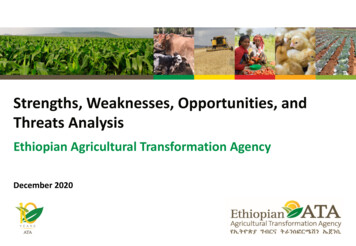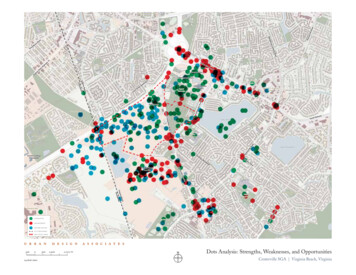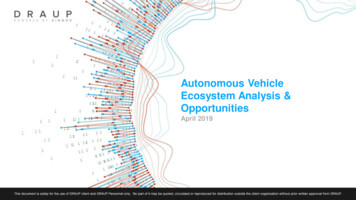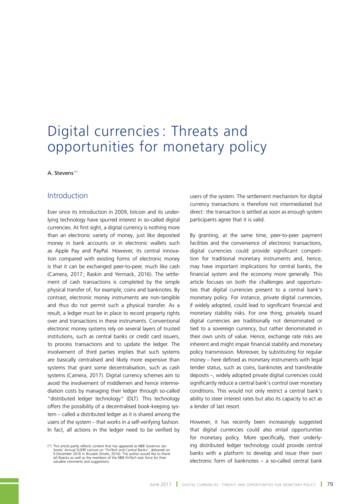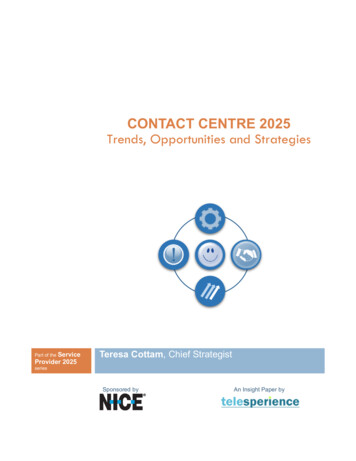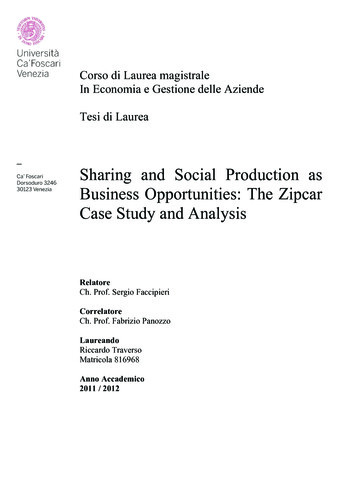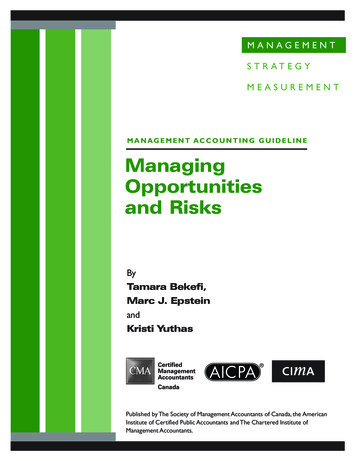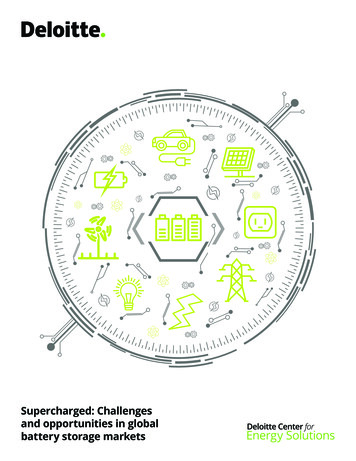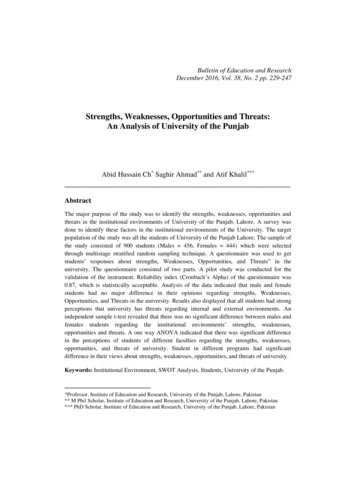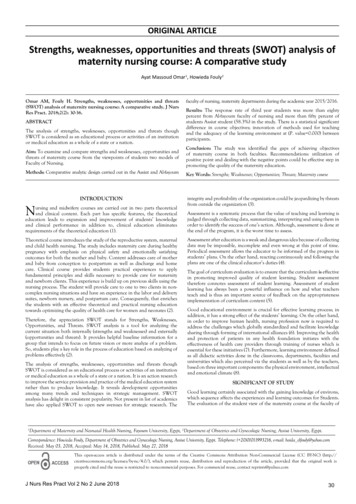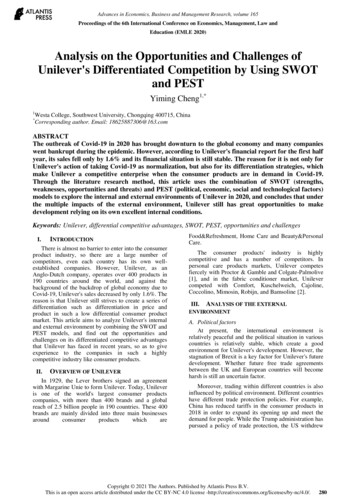
Transcription
Advances in Economics, Business and Management Research, volume 165Proceedings of the 6th International Conference on Economics, Management, Law andEducation (EMLE 2020)Analysis on the Opportunities and Challenges ofUnilever's Differentiated Competition by Using SWOTand PESTYiming Cheng1,*1Westa College, Southwest University, Chongqing 400715, ChinaCorresponding author. Email: 18625887306@163.com*ABSTRACTThe outbreak of Covid-19 in 2020 has brought downturn to the global economy and many companieswent bankrupt during the epidemic. However, according to Unilever's financial report for the first halfyear, its sales fell only by 1.6% and its financial situation is still stable. The reason for it is not only forUnilever's action of taking Covid-19 as normalization, but also for its differentiation strategies, whichmake Unilever a competitive enterprise when the consumer products are in demand in Covid-19.Through the literature research method, this article uses the combination of SWOT (strengths,weaknesses, opportunities and threats) and PEST (political, economic, social and technological factors)models to explore the internal and external environments of Unilever in 2020, and concludes that underthe multiple impacts of the external environment, Unilever still has great opportunities to makedevelopment relying on its own excellent internal conditions.Keywords: Unilever, differential competitive advantages, SWOT, PEST, opportunities and challengesI.INTRODUCTIONThere is almost no barrier to enter into the consumerproduct industry, so there are a large number ofcompetitors, even each country has its own wellestablished companies. However, Unilever, as anAnglo-Dutch company, operates over 400 products in190 countries around the world, and against thebackground of the backdrop of global economy due toCovid-19, Unilever's sales decreased by only 1.6%. Thereason is that Unilever still strives to create a series ofdifferentiation such as differentiation in price andproduct in such a low differential consumer productmarket. This article aims to analyze Unilever's internaland external environment by combining the SWOT andPEST models, and find out the opportunities andchallenges on its differentiated competitive advantagesthat Unilever has faced in recent years, so as to giveexperience to the companies in such a highlycompetitive industry like consumer products.II.OVERVIEW OF UNILEVERIn 1929, the Lever brothers signed an agreementwith Margarine Unie to form Unilever. Today, Unileveris one of the world's largest consumer productscompanies, with more than 400 brands and a globalreach of 2.5 billion people in 190 countries. These 400brands are mainly divided into three main shment, Home Care and Beauty&PersonalCare.The consumer products' industry is highlycompetitive and has a number of competitors. Inpersonal care products markets, Unilever competesfiercely with Proctor & Gamble and Colgate-Palmolive[1], and in the fabric conditioner market, Unilevercompeted with Comfort, Kuschelweich, Cajoline,Coccolino, Mimosin, Robijn, and Bamsoline [2].III.ANALYSIS OF THE EXTERNALENVIRONMENTA. Political factorsAt present, the international environment isrelatively peaceful and the political situation in variouscountries is relatively stable, which create a goodenvironment for Unilever's development. However, thestagnation of Brexit is a key factor for Unilever's futuredevelopment. Whether future free trade agreementsbetween the UK and European countries will becomeharsh is still an uncertain factor.Moreover, trading within different countries is alsoinfluenced by political environment. Different countrieshave different trade protection policies. For example,China has reduced tariffs in the consumer products in2018 in order to expand its opening up and meet thedemand for people. While the Trump administration haspursued a policy of trade protection, the US withdrewCopyright 2021 The Authors. Published by Atlantis Press B.V.This is an open access article distributed under the CC BY-NC 4.0 license 0
Advances in Economics, Business and Management Research, volume 165from the Trans-Pacific Partnership trade agreement on23 January 2017, and an overly conservative tradepolicy gave a huge challenge for Unilever's growth inUS.In Europe and the US, Unilever is not only subjectto the regulatory restrictions of the European Union andthe US Food and Drug Administration, but also subjectto the laws of the region in which it is located. Anddifferent countries have different laws. For example,the Norwegian authority relies on a regulatoryframework which imposes strict restrictions on theoperations of Unilever and requires the company tomake concessions in return in order to let the purchasego ahead [3]. However, the strengthening ofinternational patent law and the worldwide law is agreat protection and opportunity for Unilever tocontinuously develop new products.B. Economic factors1) A downturn in global economic situation: Theepidemic of Covid-19 has brought about a globaleconomic downturn, and Unilever posting six-monthsales of 25.7 billion, decreased by 1.6%. However,Unilever's downward trend is very small compared tothe 2.3% decline forecasting previously. Although theglobal economic downturn has had an impact onUnilever, the speed of Unilever dealing with Covid-19and the level of decision-making have minimized itsimpact on Unilever. At the same time, the outbreak hasbrought some local consumer product companies on thebrink of bankruptcy, which makes it a good opportunityfor Unilever's takeover. What is more, during theepidemic, Unilever rushed to develop disinfectionproducts to meet the increased market demand fordisinfection products, which are 99.999% effective.2) International exchange rate of the Pound and theEuro: Unilever's financial statements denominated inEuros. The progress of Brexit has stalled, but afterBrexit, the exchange rate between the Pound and theEuro is bound to fluctuate considerably for some time.And actually, the fluctuations of the exchange rate ofPound did impact Unilever. In 2016, caused by Brexitreferendum, the Pound fall by 16% compared with thedollar. Hence, Unilever's profits drop 21% when thecost of ice cream was denominated in US dollars andsold in UK [4].C. Social factorsAs people's standard of living improves, the demandfor high-end grocery and cosmetics is increasing. Andpeople pay more attention to health, which fits perfectlywith Unilever's three main businesses, i.e. Home Care,Beauty & Personal Care and Foods & Refreshment.What is more, Unilever is expanding into higher-endproduct lines such as health management.Simultaneously, with the continuous strengthening ofenvironmental protection awareness, Unilever hasdiscoveredthe inherentconnection betweenenvironmental protection and corporate developmentand the connection is sustainable development.Unilever has implemented the sustainable developmentstrategy, not only to achieve business growth but toenhance Unilever's positive influence in society.However, in recent years, in the consumer productindustry, the growth of local companies in variouscountries has been fierce in order to satisfy consumer'sdemand and these newly developing companies are allcompetitors for Unilever. In an interview with theFinancial Times, Paul Polman, the CEO of Unilever,said that "regional players" in emerging markets havebecome the company's most intense competitors, but hestill believes that Unilever has long-term opportunitiesin these markets.D. ormation and embracing innovation. In selectingsuitable talent, Unilever uses artificial intelligence withHR specialists [5]. At the same time, with thedevelopment of the Internet, the use of digital mediaplatform in Unilever promotes the integration withusers and suppliers, which implies that there is no needfor manual intervention in the input of transaction data,so it reduces paperwork and improves the accuracy ofdata [6].IV. ANALYSIS OF CONDITIONS WITHINUNILEVERA. Financial capabilityUnilever's total assets are financially stable andincreasing in line with the increase in operationalrequirement liabilities [7]. At the same time, Unileverhas eight major financial-related departments includingexcellent finance team, supply chain finance andfactory finance, and taxation [8], so they have strongfinancial management capabilities. However, accordingto financial analysis from 2012 to 2016, Unilever'ssolvency and liquidity are weak, and there is a potentialdebt risk [7].B. Organizational leadershipUnilever's leadership growth profile is composed ofthe following three points: Establish a growth vision (growth is the keycriterion for Unilever's employee behavior); Promote growth through implementation andmotivate others to promote growth; Ensure employees commitment to growth.As a global company, Unilever's leaders need tohave a global version, according to the survey of Floris281
Advances in Economics, Business and Management Research, volume 165A. Maljers in 1992, Unilever's board members camefrom six different countries, with almost everyoperating company including expatriates [9]. And atpresent, Unilever's Executive Director Joanne Lu, NilsAndersen, the chairman of board, and other Boardmembers have worked in different countries or forglobal companies, which is beneficial for Unilever'sglobal development.market. However, not every acquisition is successful.For example, its positioning overlapped with Unilever'sown brand positioning. The acquisition of MEGAMANtoothpaste in China had been failed and finally thebrand disappeared.3) Low price strategy: In 2009, Unilever's CEOPaul Polman changed the predecessor's pricing strategyto drive greater sales at lower prices [11]. However, thelow-price strategy cannot be sustained forever becausetoo low profit margins will reduce the profitability ofenterprises and cause vicious market competition.4) Diverse product and brand portfolio: Unilever'sproduct lines are long and deep. In China, there are sixmajor brands that focus on shampoo and hair careproducts, including TRESemmé, Hazeline, Lux, Dove,Seedology and Clear. And the range of Hazeline isdivided into six categories: Multi-Care Shampoo, BlackShine Oil Shine 2-in-1 Shampoo, Black Shine LongLasting Anti-Dandruff Shampoo, Multi-Care AntiDandruff Shampoo, Oil Control Long-Lasting AntiDandruff Shampoo and Conditioning Anti-FallShampoo. At the same time, Unilever's brand portfoliovaries from country to country, with brands beingadded and subtracted to find the most suitable productmix.C. Product marketing capabilities1) Centralized strategy and brand slimming: In the1990s, Unilever had more than 2,000 brands, but salescontinued to be sluggish. At that time, Unilever's globalCEO Niall Fitzgerald decided to reform and eliminatesome brands. In 2003, after a series of elimination andbrand reorganization, the number of Unilever's brandswas reduced to 400 and increased the influence of thecore brand continuously. By 2008, 80% of Unilever'ssales were provided by 20% of its core brands, greatlyincreasing Unilever's brand control capabilities [7].2) Localization: As local people have a deeperunderstanding of local needs, at Unilever, teammanagers are responsible for identifying talent fromlocal universities to be nurtured for "Indianisation","Australianisation", "Brazilianisation", etc. [9] At thesame time, Unilever continues to purchase localcompanies in order to reduce competition [10]. Forexample, in order to enter the US market, Unileverchose to acquire Cheseborough-Ponds, as 75% ofCheseborough-Ponds' products are sold in the USTABLE I.V.The SWOT matrix has the following strengths,weaknesses, opportunities and threats. ("Table I")SWOT MATRIXStrengthsStable financial position and strong financial strengthExperienced leaders with globalization visionCentralized brand strategy and strong brand controlLocalizationGreater sales with lower priceDiverse product and brand portfolioOpportunitiesThe international environment is peaceful (Politics)In some countries, like China, expand its opening up and decreasedtaxes (Politics)Limited by various laws of different countries (Politics)Local business bankruptcy due to covid-19 (Economy)Increased demand for high-end consumer products and cosmetics(Society)Increased environmental awareness (Society)The development of the digital technology and the Internet(Technology)Unilever's opportunities and challenges coexist inthe external environment. Although the internationalenvironment is generally peaceful, global companies,like Unilever, need to be prepared to actively respond tothe uncertain situation of Brexit and the further UStrade policy. Due to the different laws and regulationsof different countries, Unilever is subject to differentrestrictions in different countries. The outbreak Covid-SWOT MATRIXWeaknessesWeak solvency and liquidityNational brand killer and have many failed acquisitionsVicious market competition caused by low priceThreatsFree trade agreements between the UK and Europeancountries is uncertain because of Brexit (Politics)In some countries, like America, implement a conservativetrade policy (Politics)Improvements to international patent law (Politics)A global economic downturn due to Covid-19 (Economy)Fluctuations of exchange rate between Pound and Euro isuncertain. (Economy)The rise of local companies (Society)19 in 2020 has caused the global economy to decline,but Unilever responded to the epidemic in time andseized the opportunity to do research to resist Covid-19,which reduced the impact of the epidemic on Unilever.The pull of social demand and the development oftechnology also have created opportunities for Unileverto further expand its operations.282
Advances in Economics, Business and Management Research, volume 165In the internal environment, Unilever's st
Analysis on the Opportunities and Challenges of Unilever's Differentiated Competition by Using SWOT and PEST Yiming Cheng1,* 1Westa College, Southwest University, Chongqing 400715, China *Corresponding author. Email: 18625887306@163.com ABSTRACT The outbreak of Covid-19 in 2020 has brought downturn to the global economy and many companies
